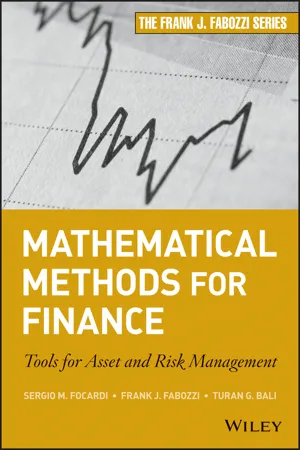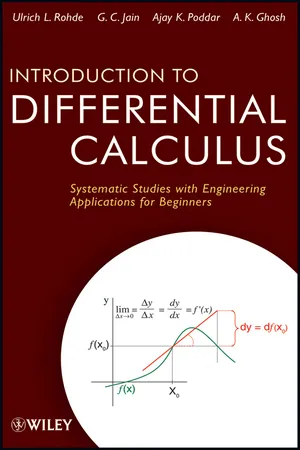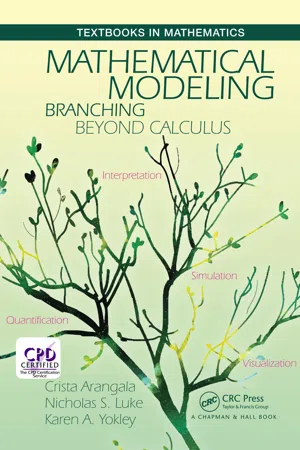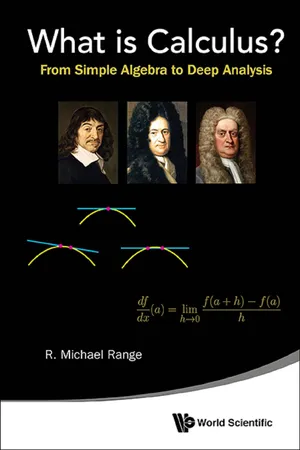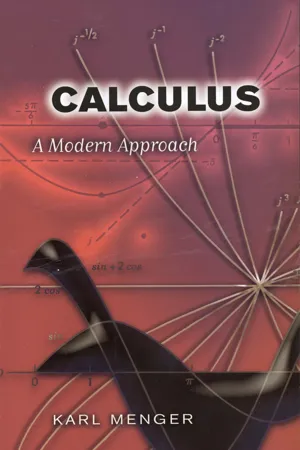Mathematics
Derivatives
In mathematics, derivatives represent the rate of change of a function at a given point. They are used to calculate slopes, velocities, and rates of change in various real-world applications. Derivatives are fundamental in calculus and are essential for understanding the behavior of functions and solving optimization problems.
Written by Perlego with AI-assistance
Related key terms
7 Key excerpts on "Derivatives"
- eBook - ePub
Mathematical Methods for Finance
Tools for Asset and Risk Management
- Sergio M. Focardi, Frank J. Fabozzi, Turan G. Bali(Authors)
- 2013(Publication Date)
- Wiley(Publisher)
derivative . Graphically, the derivative is the steepness of the tangent to a curve.Starting from this definition and with the help of a number of rules for computing a derivative, it was shown that the instantaneous rate of change of a number of functions—such as polynomials, exponentials, logarithms, and many more—can be explicitly computed as a closed formula. For example, the rate of change of a polynomial is another polynomial of a lower degree.The process of computing a derivative, referred to as derivation or differentiation , solves the problem of finding the steepness of the tangent to a curve and is the subject of this chapter. The process of integration solves the problem of finding the area below a given curve and is the subject of the next chapter. The reasoning is similar. The area below a curve is approximated as the sum of rectangles and is defined as the limit of these sums when the rectangles get arbitrarily small.As explained in the next chapter, a key result of calculus is the discovery that integration and differentiation are inverse operations: Integrating the derivative of a function yields the function itself.LIMITSThe notion of limit is fundamental in calculus. It applies to both functions and sequences. Consider an infinite sequence S of real numbersIf, given any real number > 0, it is always possible to find a natural number i ( ) such thatthen we writeand say that the sequence S tends to a when n tends to infinity, or that a is the limit of the sequence S.Two aspects of this definition should be noted. First, can be chosen arbitrarily small. Second, for every choice of , the difference in absolute value, between the elements of the sequence S and the limit a is smaller than for every index i above i ( ). This translates the notion that the sequence S gets arbitrarily close to a as the index i grows.We can now define the concept of limit for functions. Suppose that a real function y = f (x ) is defined over an open interval (a , b ), that is, an interval that excludes its end points. If, for a real number c in the interval (a , b ), there is a real number d such that, given any real number > 0, it is always possible to find a positive real number r ( - eBook - ePub
Introduction to Differential Calculus
Systematic Studies with Engineering Applications for Beginners
- Ulrich L. Rohde, G. C. Jain, Ajay K. Poddar, A. K. Ghosh(Authors)
- 2012(Publication Date)
- Wiley(Publisher)
Chapter 9 The Idea of a Derivative of a Function 9.1 IntroductionThere are certain problems in mathematics, mechanics, physics, and many other branches of science, which cannot be solved by ordinary methods of geometry or algebra alone . To solve these problems, we have to use a new branch of mathematics known as calculus. It uses not only the ideas and methods from arithmetic, geometry, algebra, coordinate geometry, trigonometry, and so on, but also the notion of limit , which is a new idea that lies at the foundation of calculus . Using this notion as a tool, the derivative of a function is defined as the limit of a particular kind.The idea of derivative of a function is among the most important and powerful concepts in mathematics. This concept distinguishes calculus from other branches of mathematics. It will be found that the derivative of a function is generally a new function (derived from the original function). We call it the rate function or the derivative function.Calculus is the mathematics of change. The immense practical power of calculus is due to its ability to describe and predict the behavior of changing quantities. We cannot even begin to answer any question related to change unless we know what changes and how it changes? Let us discuss.We know that- the area of a circle, A (r ) = πr 2 , changes with (respect to) its radius “r ”.
- the volume of a sphere, ( ), changes with (respect to) its radius “r ”.
- the surface area of a cube, S(l ) = 6l 2 , changes with (respect to) the length “l ” of its side.
Consider a function y = h (x ) whose graph is a smooth curve (not a straight line). Then, the inclination “θ” of the tangent line (drawn at any point of the curve) changes from point to point on the curve. (Later on, this observation will be used to define a (new) concept, namely, “the slope of a curve - eBook - ePub
Mathematical Modeling
Branching Beyond Calculus
- Crista Arangala, Nicolas S. Luke, Karen A. Yokley(Authors)
- 2018(Publication Date)
- Chapman and Hall/CRC(Publisher)
2Modeling with Calculus
Goals and Expectations
The following chapter is written toward students who have completed two or more semesters of collegiate calculus. Goals:- Section 2.1 (Using Derivatives and Rates of Change): To develop skills connecting Derivatives to rates of change in context.
- Section 2.2 (Optimization):
- To review optimization concepts from introductory calculus.
- To use calculus to determine the best values in physical applications.
- Section 2.3 (Accumulation): To develop skills connecting integrals and the idea of accumulation to applications.
- Section 2.4 (Volumes): To use integrals calculating volumes of rotation in the context of applications.
- Section 2.5 (Sequences and Series): To use sequences and series to describe and learn about applications.
2.1 Using Derivatives and Rates of Change
The derivative of a differentiable function describes the original function’s instantaneous rate of change at any particular input. When a differentiable function is used as a model to describe an application, the first and second Derivatives of that function can provide valuable information about the situation being modeled. This section will focus on how Derivatives can be used to learn more about applications.Recall for a differentiable function f (x ):- f (x ) is increasing when .f ′( x )> 0
- f (x ) is decreasing when .f ′( x )< 0
Hence, if a model is known to describe a particular situation, the derivative of that model could be used to learn about how quickly the output is increasing or decreasing. Further, the second derivative informs how the first derivative of a function is increasing or decreasing, and this acceleration of the function can also help us understand how an application is changing.Example 2.1.1Patricia has $1000 dollars saved. She wants easy access to her money and does not want to risk losing any of it, so she decides to open a savings account at a local bank even though the interest rate will be very low. Patricia has identified options at different banks: (A) an account that has an annual interest rate of 0.5% compounded quarterly and (B) an account that has an annual interest rate of 0.45% compounded monthly. - eBook - ePub
- Richard A. Silverman(Author)
- 2013(Publication Date)
- Dover Publications(Publisher)
(3) is just the changef (x 0 + h ) − f (x 0 )in the dependent variable y = f (x ) when the independent variable x is changed from x 0 to x 0 + h , while the denominator of (3) is just the change(x 0 + h ) − x 0 = hin x itself. Therefore the difference quotient itself becomesand the derivative is the “limiting value” of this “change ratio” as the change in the independent variable x gets “smaller and smaller,” that is, “approaches zero.” As for the word “rate,” which suggests something changing with respect to time, it is a metaphor borrowed from problems involving motion, where the independent variable is indeed time (usually denoted by t ), and the dependent variable changes with respect to time at a certain “rate.”d. In Sec. 1.12 we described calculus as the “mathematics of change” and formulated the two basic types of problems with which calculus deals. The first of these problems was stated in the following unsophisticated language:We are now in a position to restate this problem in more precise language:(1)Given a relationship between two changing quantities, what is the rate of change of one quantity with respect to the other?(1′) Given a function y = f (x ), what is the rate of change of y with respect to x ?The study of this problem is the province of a branch of calculus known as differential calculus and always involves the calculation of a derivative.2.43. Examplesa. Find the derivative of the function f (x ) = x 2 at an arbitrary point x 0 .SOLUTION . For this function we havewhich becomesafter doing a little algebra. But as h gets “closer and closer” to 0, the quantity 2x 0 + h gets “closer and closer” to 2x 0 , for the simple reason that the distance between the points 2x 0 + h and 2x 0 - eBook - ePub
- Frank Werner, Yuri N. Sotskov(Authors)
- 2006(Publication Date)
- Routledge(Publisher)
4 Differentiation
In economics, there are many problems which require us to take into account how a function value changes with respect to small changes of the independent variable (e.g. input, time, etc.). For example, assume that the price of some product changes slightly. The question is how does this affect the amount of product customers will buy? A useful tool for such investigations is differential calculus, which we treat in this chapter. It is an important field of mathematics with many applications, e.g. graphing functions, determination of extreme points of functions with or without additional constraints. Differential calculus allows us to investigate specific properties of functions such as monotonicity or convexity. For instance in economics, cost, revenue, profit, demand, production or utility functions have to be investigated with respect to their properties. In this chapter, we consider functions f : Df → ℝ depending on one real variable, i.e. Df ⊆ ℝ.4.1 LIMIT AND CONTINUITY
4.1.1 Limit of a function
One of the basic concepts in mathematics is that of a limit (see Definition 2.6 for a sequence). In this section, the limit of a function is introduced. This notion deals with the question of which value does the dependent variable y of a function f with y = f (x) approach as the independent variable x approaches some specific value x0 ?Definition 4.1 The real number L is called the limit of function f : Df → ℝ as x tends to x0 if for any sequence {xn } with xn ≠ x0 , xn ∈ Df , n = 1, 2, . . . , which converges to x0 , the sequence of the function values {f (xn )} converges to L.Thus, we say that function f tends to number L as x tends to (but is not equal to) x0 . As an abbreviation we writeNote that limit L must be a (finite) number, otherwise we say that the limit of function f as x tends to x0 does not exist. If this limit does not exist, we distinguish two cases. If L = ±∞, we also say that function f is definitely divergent as x tends to x0 , otherwise function f is said to be indefinitely divergent as x tends to x0 - eBook - ePub
What is Calculus?
From Simple Algebra to Deep Analysis
- R Michael Range(Author)
- 2015(Publication Date)
- WSPC(Publisher)
Chapter IIDerivatives: How to Measure Change
As seen in the Prelude, Derivatives—which were introduced by algebraic techniques based on double points and multiplicities—provide the solution to the ancient problem of finding tangent lines for large classes of curves. These elementary methods, however, fail in the case of non-algebraic functions, in particular for the important case of exponential functions. Motivated by the application to velocity that we considered in Section 4 of the Prelude, we recognized that Derivatives can also be captured by an approximation process, e.g., the velocity at time t 0 is approximated by average velocities over decreasing time intervals containing t 0 . Such average velocities, or more generally, average rates of change, are very easy to define. The main new difficulty thus concerns understanding the approximation process and developing a general setting where it leads to meaningful results. Starting with the elementary case of algebraic functions and guided by the example of exponential functions, we shall now investigate this approximation process in detail, culminating with a notion of differentiability that generalizes the algebraic formulation and that is equivalent to the classical version used in analysis. Along the way we shall highlight the interpretation of Derivatives as instantaneous rate of change , a concept that is the foundation for the numerous applications of calculus to the natural sciences over several centuries and to many other disciplines in more recent times.Before proceeding with this chapter, the reader is urged to review Sections 4 and 8 of the Prelude.II.1 Algebraic Derivatives by Approximation
II.1.1 From Factorization to Average Rates of Change
As we saw in the Prelude, given a polynomial f and a point a ∈ , the elementary algebraic factorizationwhere q is a uniquely determined polynomial, provides the critical information to solve the tangent problem for the curve that is defined by f . In fact, the value q (a ) is the slope of that unique line through the point P = (a , f (a )) that intersects the graph of f with multiplicity 2 or higher. This is the special property that singles out the tangent line to the graph at P , and the value q (a ) is called the derivative D (f )(a ) = f ′(a ) of f at a - eBook - ePub
Calculus
A Modern Approach
- Karl Menger(Author)
- 2014(Publication Date)
- Dover Publications(Publisher)
CHAPTER VI
THE BASIC CONCEPTS OF CALCULUS
In Chapters I – III , the two basic problems of calculus were solved accurately for step lines and polygons, and approximately for simple curves. The results about functions and limits obtained in Chapters IV and V yield accurate solutions for certain curves and functions.1. THE DERIVATIVE
The slope of the chord of j2 between .75 and b (between a and b) is for any b ≠ .75 andIf then this slope isThus the slope of the tangent to j2 at .75 (and at a) isThe numerical variable b may be replaced by any other letter, as inAll these synonymous formulas express the property of the function , which might be called the difference quotient of j2 at . 75 (See Fig. 17 , p. 34 .)More generally, the slope of the chord of the curve f between a and b is the difference quotient a of f between a and b, that is, the value for b of the function , which will hereinafter be called the difference quotient of f at a. In view of f at a. In view of j a = a and f j = f, it may be written in the more symmetrical formsIf this difference quotient has a limit at a, then this limit is the slope, D f a, of the tangent of f. ThusFor instance, according to pp. 122 and 120 ,a for any rational exponent r, and any a in Dom jr . On the other hand, the difference quotient of the function abs at 0 is and assumes the value 1 on P, and the value − 1 on N. The symbol and consequently the symbol D abs 0, is meaningless. There fore, the function abs has no derivative at 0 and, indeed, the curve abs has a corner at 0.f having no derivative at a and no tangent at a must not be confused with f having the derivative 0 (zero) at a, that is, having a horizontal tangent at a. Whereas abs has a corner at 0, the curves j2 and j3 have horizontal tangents at 0. The line 4
Learn about this page
Index pages curate the most relevant extracts from our library of academic textbooks. They’ve been created using an in-house natural language model (NLM), each adding context and meaning to key research topics.
